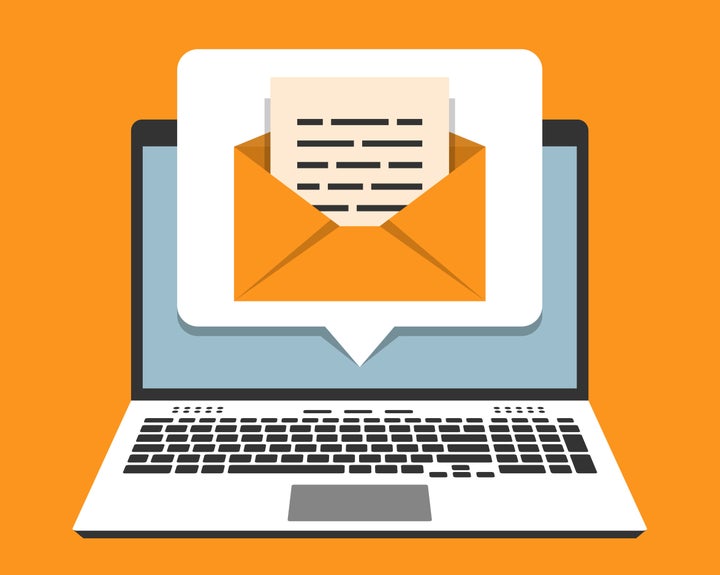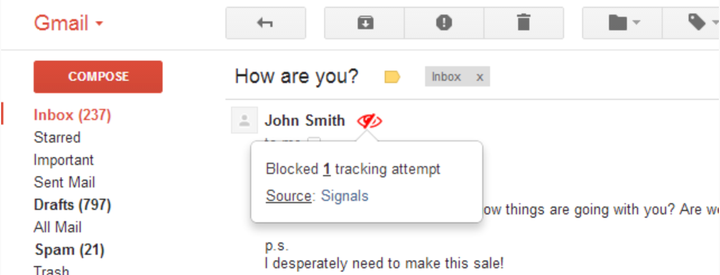
When I became a freelance writer after a job layoff a few years ago, I realized that waiting had become a second unpaid occupation. “It’s been more than five days since I emailed a story pitch. Is my recipient just busy, ill, on vacation or totally disinterested?” I worried. The not-knowing was the worst part.
It was under this mounting frustration and anxiety that, on the recommendation of a fellow freelancer, I downloaded a tool originally meant for marketers but increasingly used by people who want to know if and when someone had actually seen their casually desperate “just following up” message: an email tracker.
Email trackers are everywhere
Email tracking is a basic but effective tool of surveillance that has taken over most inboxes. It typically employs a tiny pixel image attached to your email that is invisible to you, but once you open the email, the image is loaded from a server and the server records that data for the tracking agency. These trackers vary in precision. Some are similar to read receipts that inform you when and how often an email is read, while others track clicks and downloads or let a sender know when and where an email was opened.
In 2018 research at Princeton University, computer scientists estimated that 70 percent of mailing lists were using tracking tools. Email trackers are also widely used by marketers and salespeople to time follow-up messages, but more of us are using it outside of those parameters.
Acknowledgment that your message has been received can be useful in the workplace, for example: In a recent Jezebel story, a reporter disclosed that she used an email tracker to confirm that her subject read her emails seeking comment. Freelance writers detailed to HuffPost how they use it to gather feedback about their ideas when pitching clients and to cut down on the time they waste waiting for replies.
Sixteen percent of conversational emails are tracked, according to a 2017 report from “email intelligence” startup One More Company.
A BuzzFeed feature on Jay-Z fan David Johnson details one such example. Johnson sent the rapper over 200 emails tracked via the company ReadNotify for years, telling Jay-Z detailed stories about his life without ever receiving a reply. “[Jay-Z] has opened every single one of my emails, even re-opening them to re-read,” said Johnson. “He has clicked on links and had emails open for as long as 20 minutes.”
That information eventually became a source of frustration, raising the question was it even worth it?
How to know who is using email trackers on you
To discover the email trackers at work in my inbox, I used Ugly Email, a Gmail extension that blocks trackers and puts an eyeball in the subject line of an email being tracked. For me, that open eye revealed just how many people are seeking to see my inbox activity.

PixelBlock is another Gmail extension; it blocks email trackers and tells you how many times a sender has tried to track it.

Unfortunately, those extensions are limited to Gmail. In Outlook and Thunderbird, however, not loading images ― including pixel trackers ― is the default method of viewing email, so tracking programs are limited if users don’t change that setting.
Once I started tracking the trackers, I realized many senders are watching me open emails. The knowledge can be unsettling. Almost three in four Americans in a 2015 Pew Research Center tech survey said it was “very important” for them “be in control of who can get information about them.” Email trackers take away that agency by telling unknown colleagues, marketers and scammers about your whereabouts and habits. And your privacy can easily be leaked: The Princeton report found that 30 percent of mailing lists leaked recipients’ email addresses to third-party trackers. When you use an email tracker, you are subjecting a recipient to whatever privacy policy and practices that company holds.
“I’m personally okay with read receipts on a messaging platform because there is that expectation, but with email there often isn’t,” said Sydney Li, a staff technologist at the digital rights group Electronic Frontier Foundation who has studied email trackers. “Betraying people’s expectations and potentially leaking their info to really leaky or insecure third-party tracker concerns me a lot.”
Tatiana Walk-Morris, a freelance journalist who uses the free version of Mailtrack when emailing pitches to editors, said she’s aware that email trackers can be perceived as invasive but emphasized the scale of impact was relatively small in her case as compared to marketing uses. “We’re not the same as Google ads that are following you and having cookies,” she said. “We’re not major corporations; we’re just small people who are trying to feed ourselves.”
Still, feeling under constant surveillance does not make us feel great. Research has linked electronic surveillance at work to greater stress.
How to block email trackers
If you do not want to be subject to email trackers, you should know that there is not one foolproof method since email clients change and evolve.
But one tip is to disable the autoloading of images in emails, which would include any invisible tracking pixels. “Turning off remote images will prevent read receipts for 90 percent of these cases,” Li said.
- On an iPhone, you can go to Settings, click Mail, and swipe left on the “Load Remote Images” option to turn it off.
- On an Android device, select “Ask before showing” when you tap Images.
As noted earlier, Outlook and Thunderbird disable loading images as their default setting, so the above steps aren’t necessary.
But all email users can also go one step further and disable the use of HTML in inboxes, as recommended by Electronic Freedom Frontier. “Almost all of the privacy leaks in email come from different email clients essentially implementing HTML in different ways. If you turn that off entirely, you have pretty much sanitized yourself from any potential data leak,” Li said. HTML is the web language email trackers read to tell external servers about your email interactions. You may lose your ability to use GIFs and see fonts, but it can make your email more secure.
Is knowledge really power?
Walk-Morris sees the use of email tracking as a symptom of the larger uncertainty that comes with freelancing. “I feel there is a broader shift in our industry towards freelancers. I think if we start to work out those kinks of payments and of getting back to people within a reasonable timeframe, the need for this stuff will go away a bit.”
She noted that freelancers may not have a company contact who is going to be open and transparent with them, and email tracking provides an independent form of transparency. “Making sure that your stuff is getting read and being seen by somebody is a way to understand what’s happening,” she said. “We’re on the outside looking in, we don’t know if people are paying attention to us.”
For me, however, email tracking gave me more questions than answers. At first, the additional data point gave me a sense of control in a job hunting process that was largely out of my control.
But soon I realized it did not solve my anxiety so much as organized it. It gave me new rhythms to waiting. I could know that an editor clicked an email and create ambiguous conclusions about why that email was opened several times throughout the day.
But just because something was potentially read does not mean I was acknowledged. It was maddening to watch an email be opened repeatedly when my written follow-ups were not getting a reply. My dissatisfaction reminded me of poet Mary Oliver’s analysis of how being looked at is not the same as being known: “Attention without feeling,” she wrote, “is only a report. An openness —an empathy— was necessary if the attention was to matter.”
Lauren Sarah Cocking, a freelance food, drink and travel writer, advises others to interpret the tracker’s information as an indication rather than a hard science. “You have to find your own way of interpreting it. It’s not an exact science. You can’t be too obsessive with it. Don’t take it as a given. Don’t make blanket statements.”
But there was also the privacy tradeoff in which my recipients were unaware I’d entangled them. I felt uneasy over having knowledge about other people’s email habits that they did not explicitly opt into. Unlike a typical read receipt, the email tracker I used did not let both parties know that the messages were being tracked. If you want to continue to use email trackers, informing your recipient of the tracking expectation is the ethical decision ― one I did not make.
“I think it is more ethical if you inform the other party that they are being tracked,” Li said.
For my own sanity, I got rid of the email tracker. I learned to live without the resolution of knowing if my colleagues saw my email. The lack of response would have to be answer enough.